Abstract
Trichloroethylene (TCE) induces liver cancer in mice but not in rats. Three metabolites of TCE may contribute--chloral hydrate (CH), dichloroacetate (DCA), and trichloroacetate (TCA). CH and TCA appear capable of only inducing liver tumors in mice, but DCA is active in rats as well. The concentrations of TCA in blood required to induce liver cancer approach the mM range. Concentrations of DCA in blood associated with carcinogenesis are in the sub-microM range. The carcinogenic activity of CH is largely dependent on its conversion to TCA and/or DCA. TCA is a peroxisome proliferator in the same dose range that induces liver cancer. Mice with targeted disruptions of the peroxisome proliferator-activated receptor alpha (PPAR-alpha) are insensitive to the liver cancer-inducing properties of other peroxisome proliferators. Human cells do not display the responses associated with PPAR-alpha that are observed in rodents. This may be attributed to lower levels of expressed PPAR-alpha in human liver. DCA treatment produces liver tumors with a different phenotype than TCA. Its tumorigenic effects are closely associated with differential effects on cell replication rates in tumors, normal hepatocytes, and suppression of apoptosis. Growth of DCA-induced tumors has been shown to arrest after cessation of treatment. The DCA and TCA adequately account for the hepatocarcinogenic responses to TCE. Low-level exposure to TCE is not likely to induce liver cancer in humans. Higher exposures to TCE could affect sensitive populations. Sensitivity could be based on different metabolic capacities for TCE or its metabolites or result from certain chronic diseases that have a genetic basis.
Full text
PDF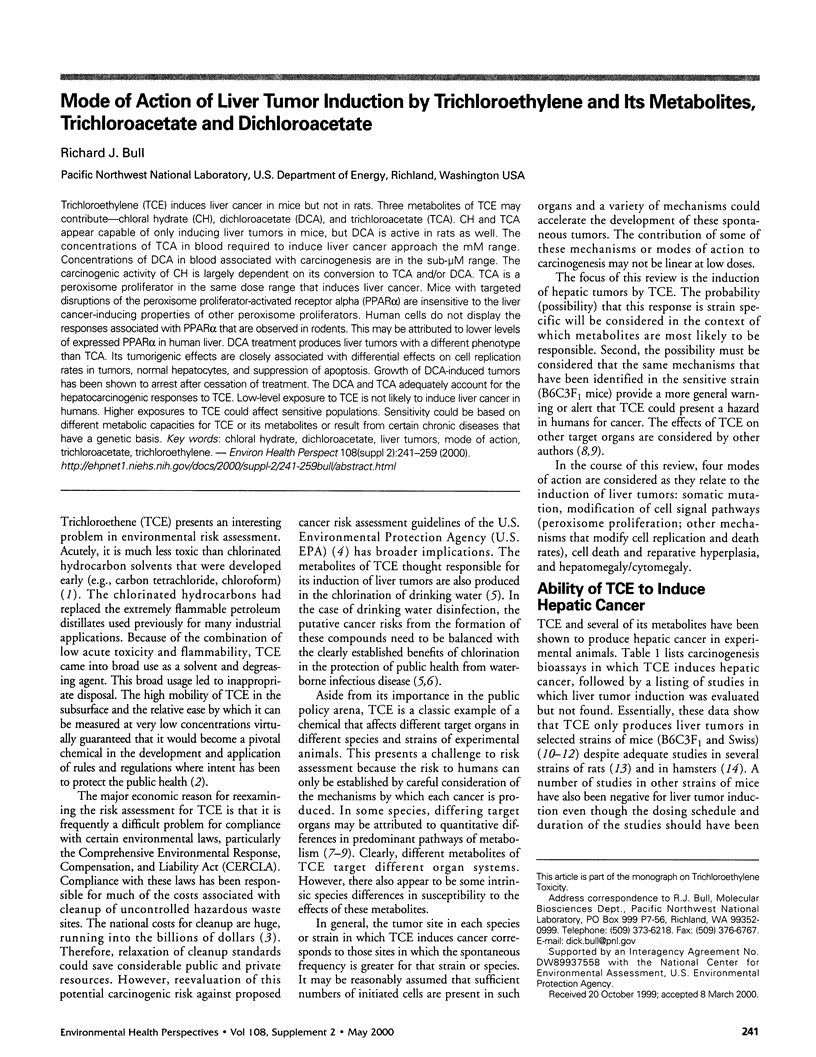
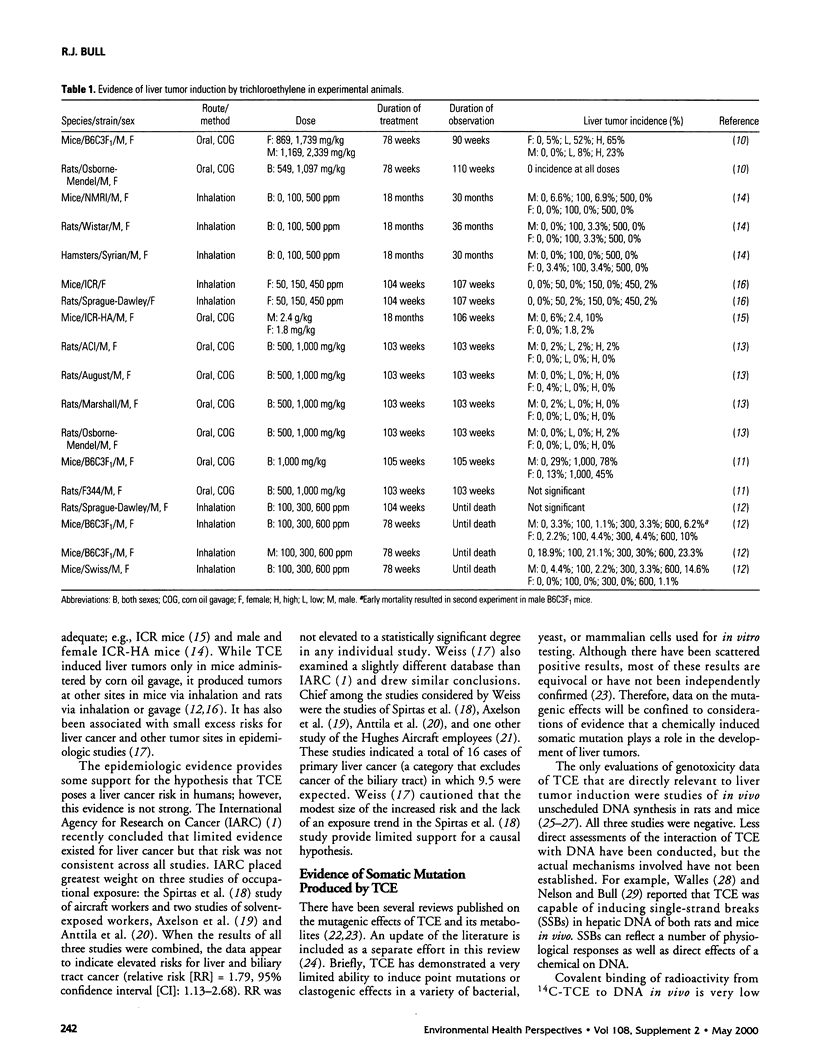
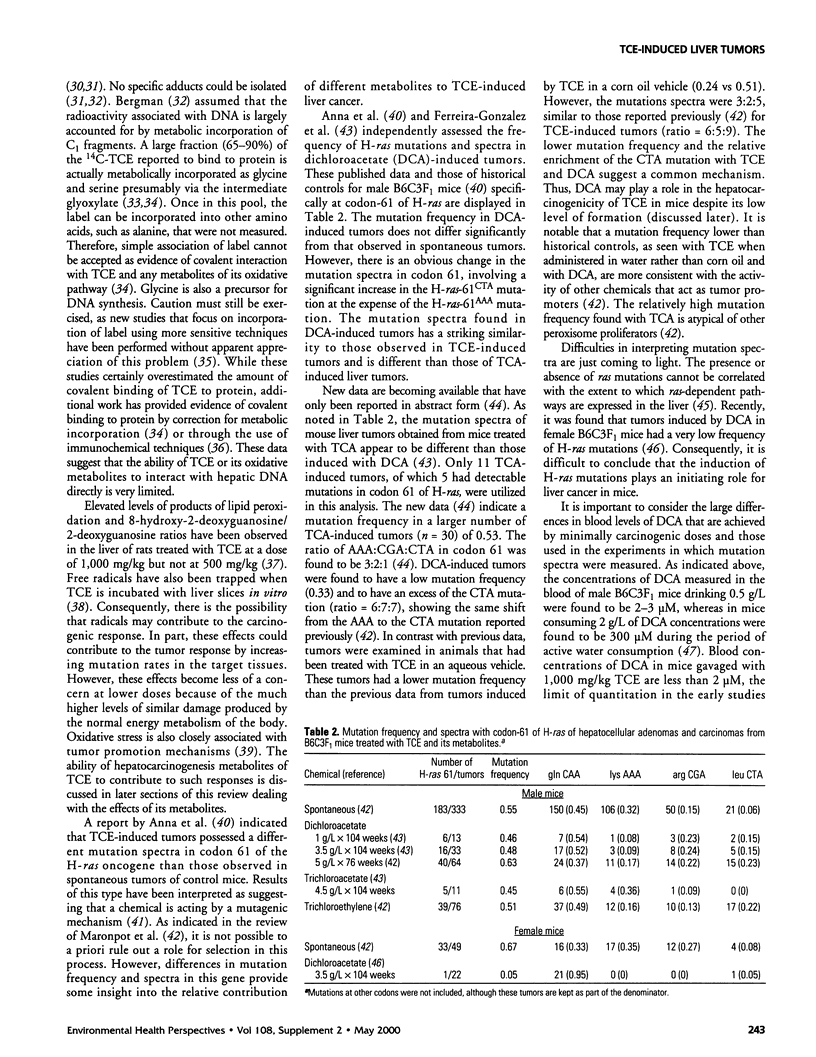
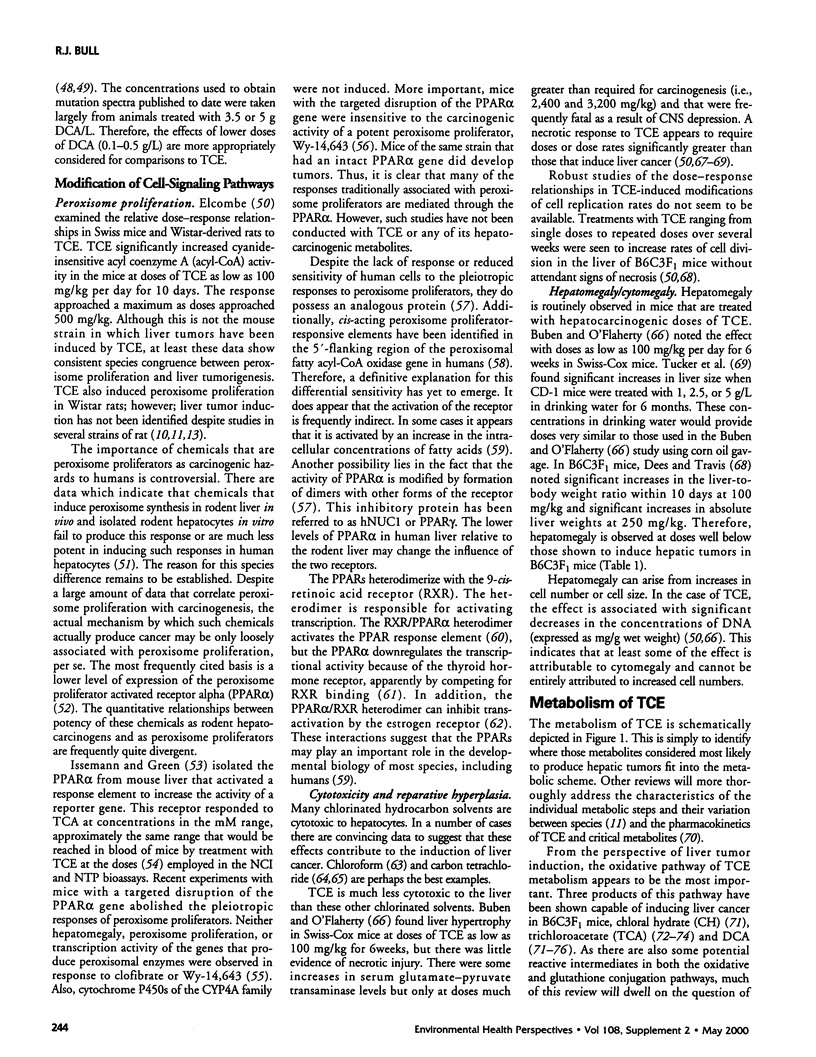
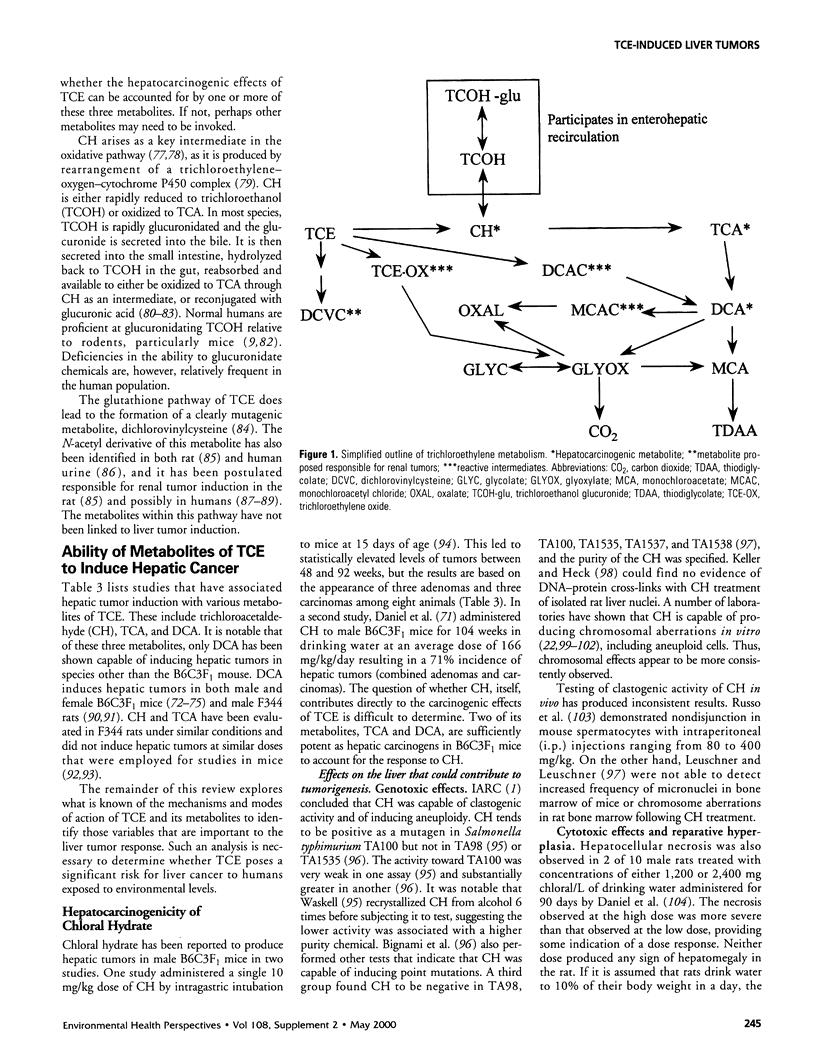

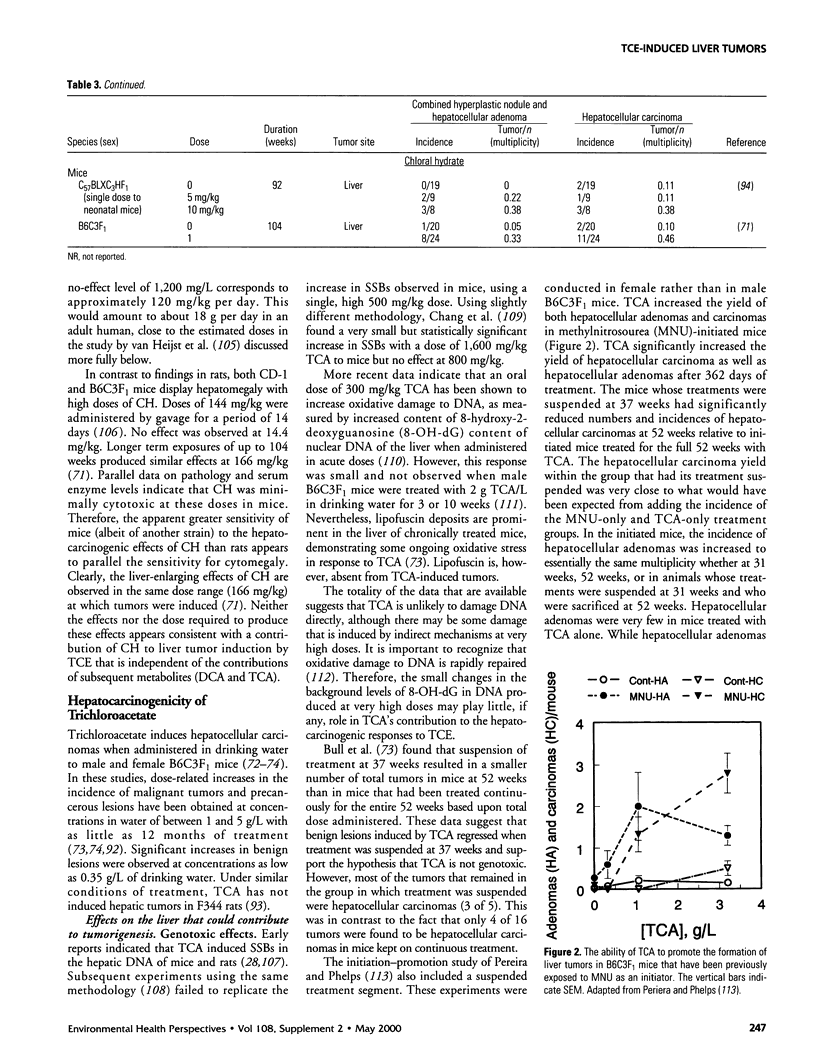
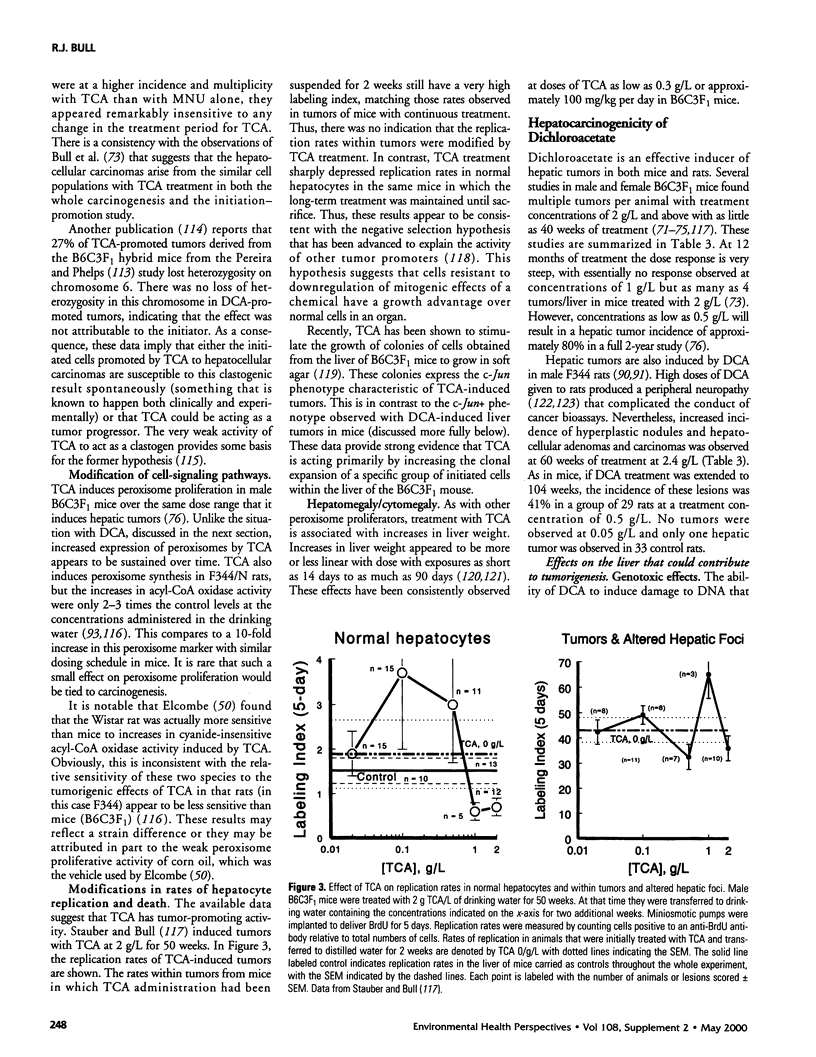
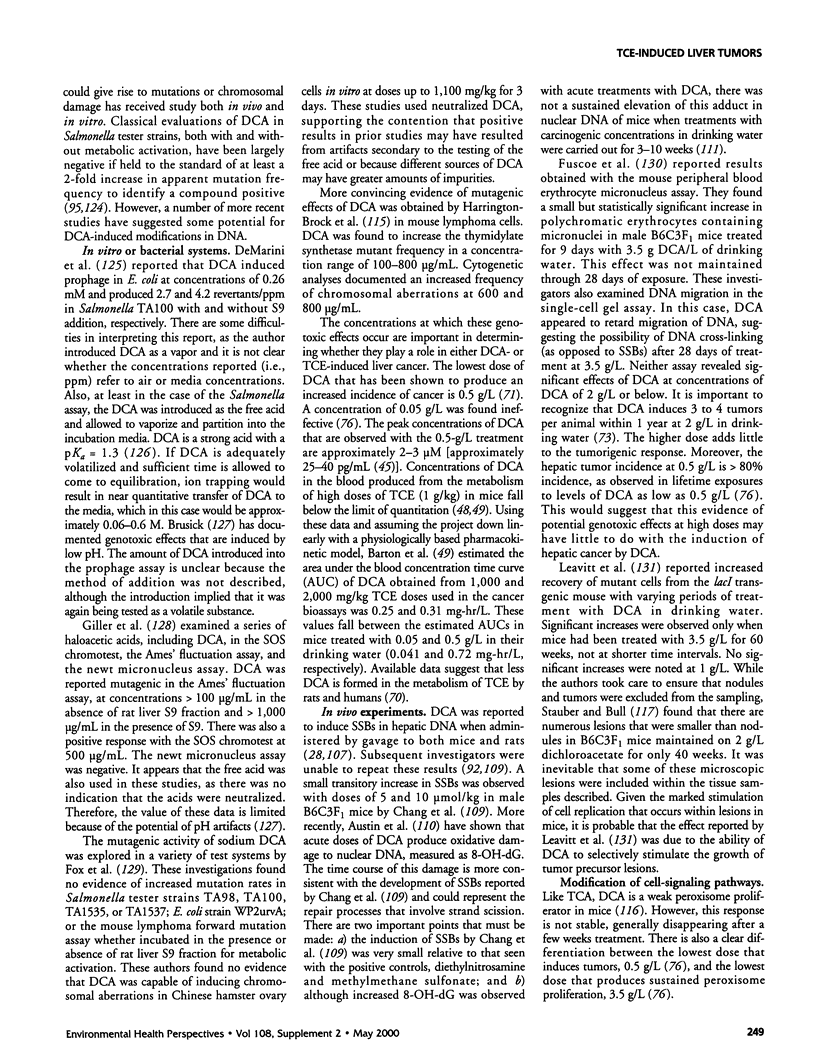
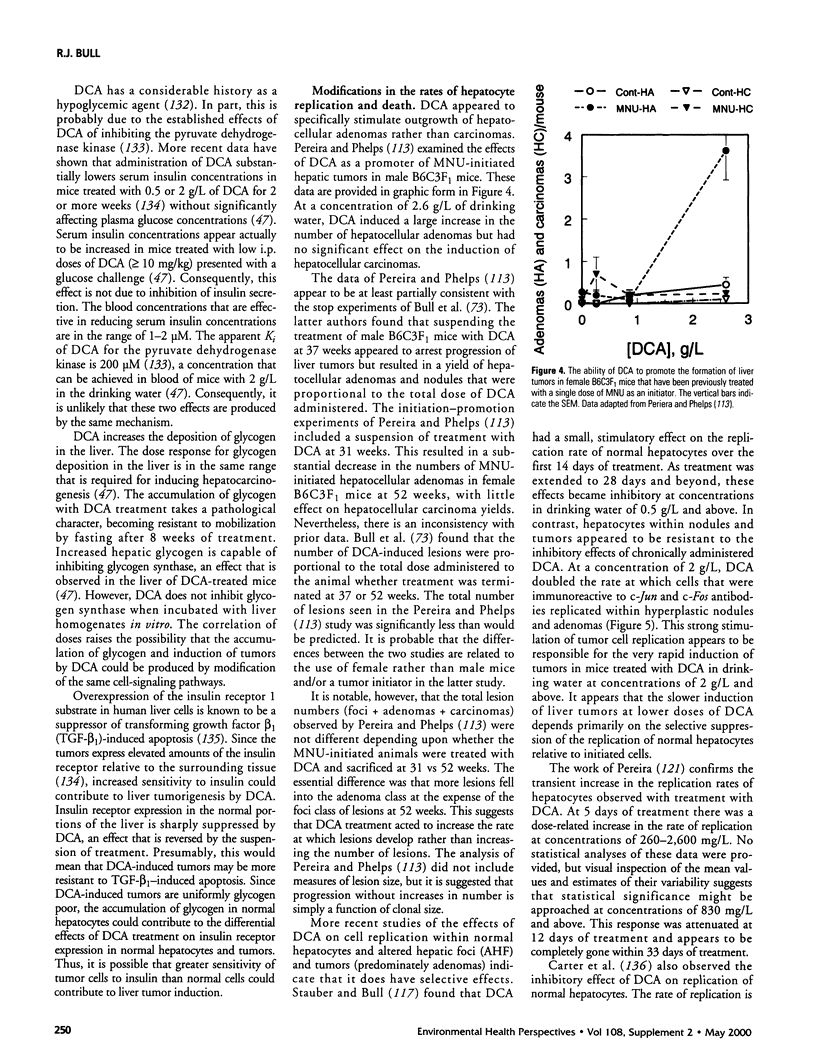
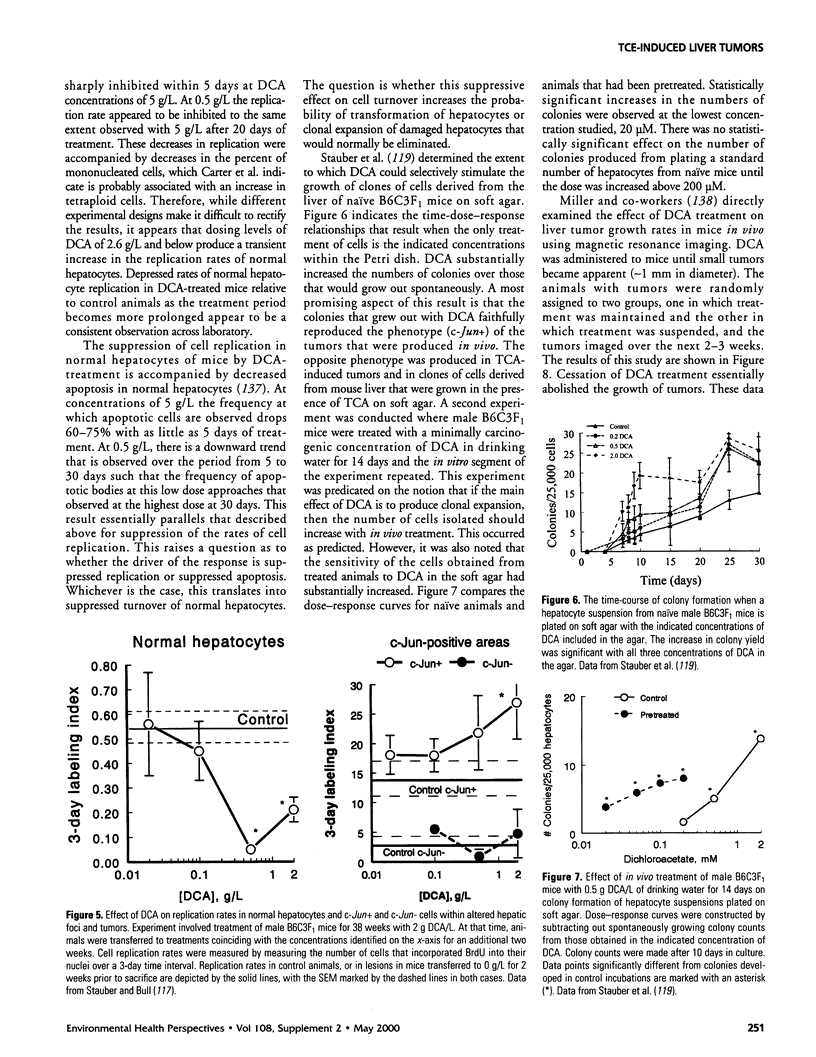
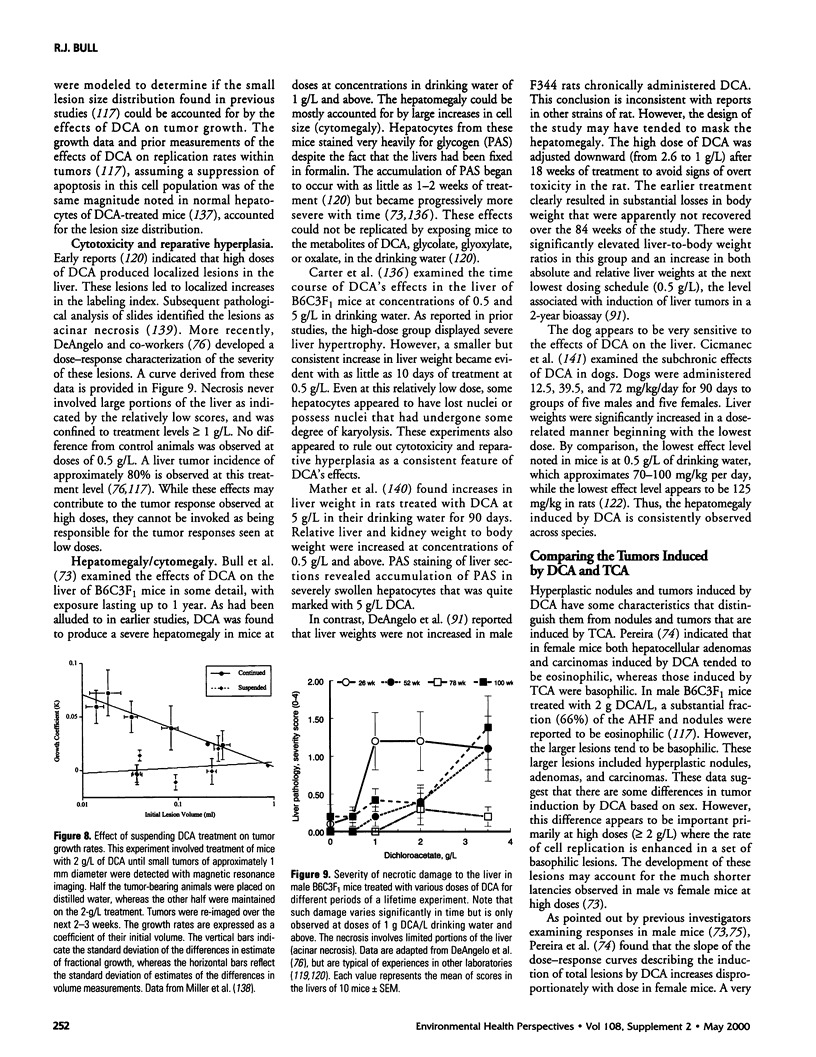

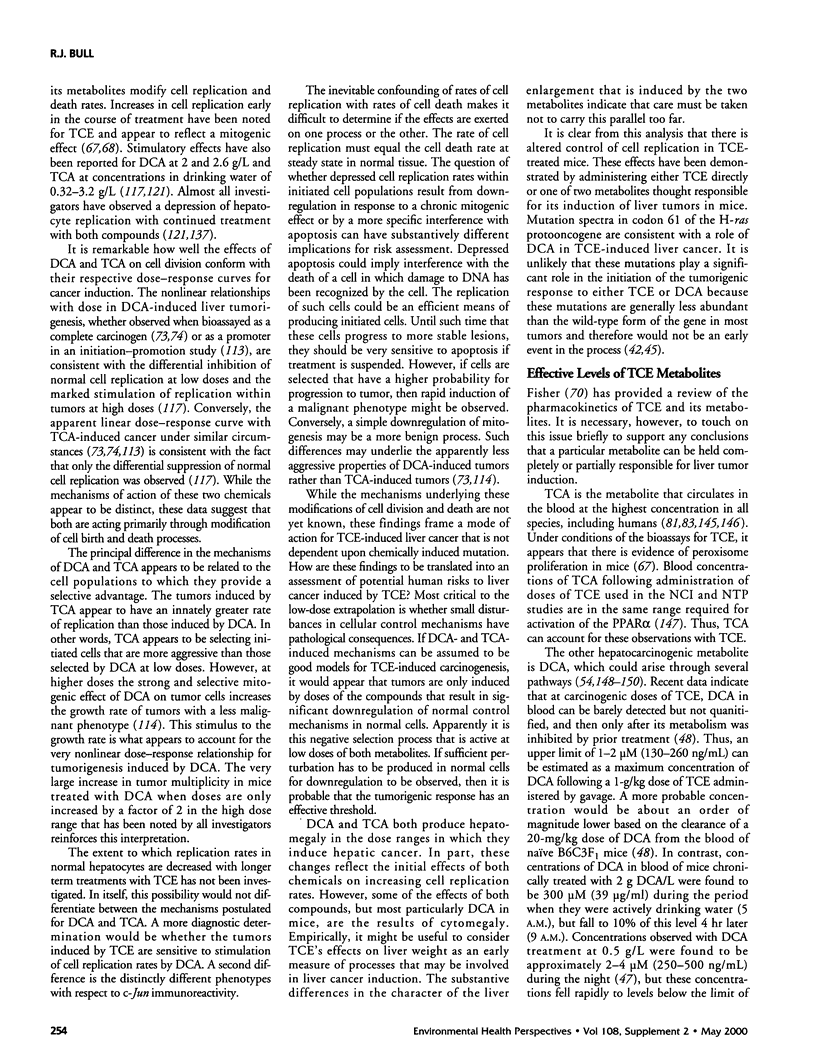


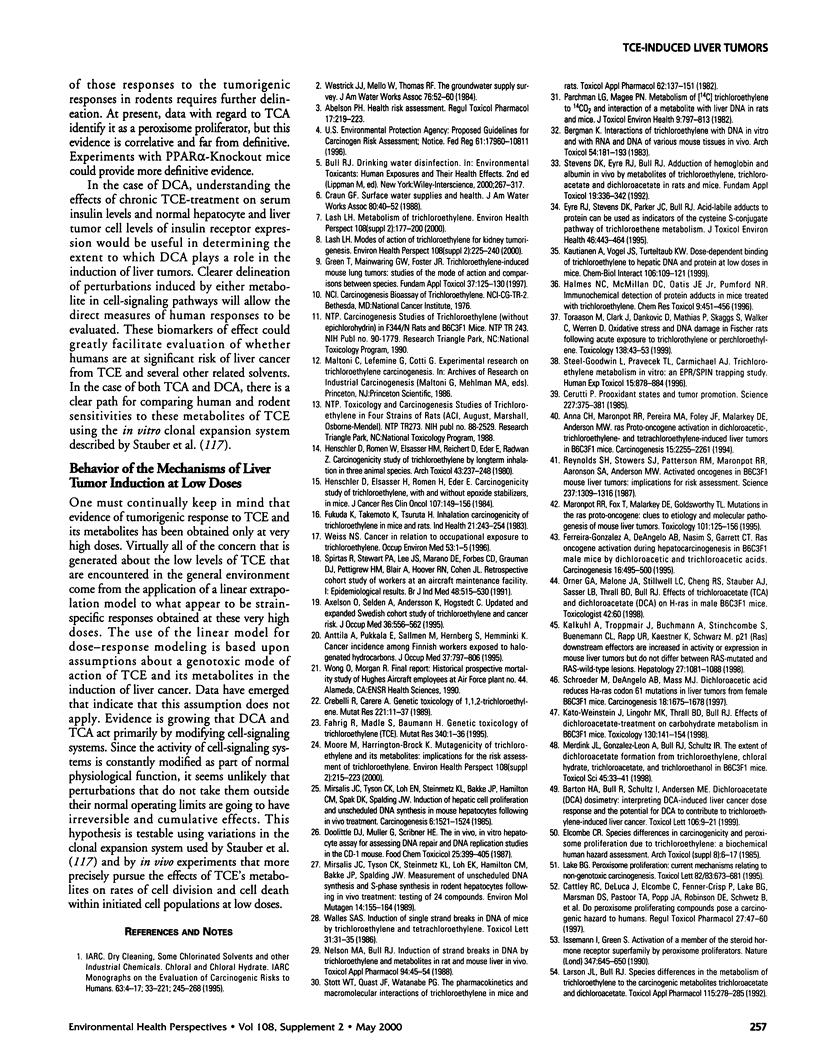
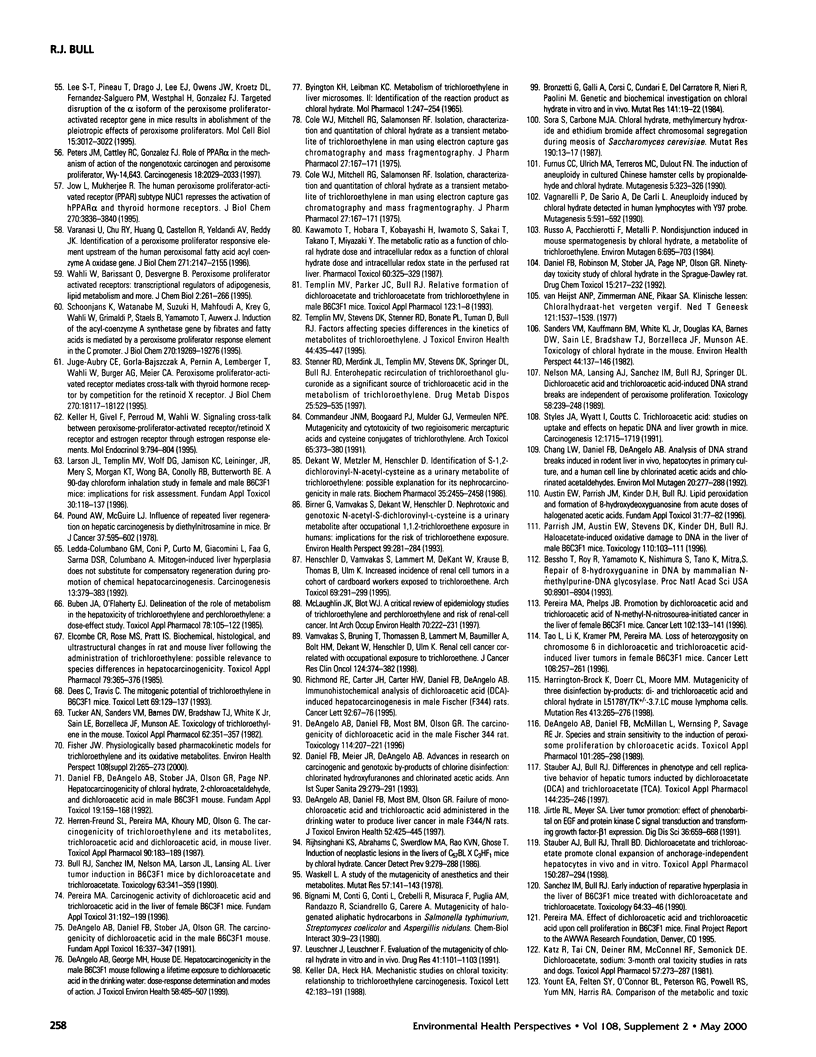

Selected References
These references are in PubMed. This may not be the complete list of references from this article.
- Abbas R. R., Seckel C. S., Kidney J. K., Fisher J. W. Pharmacokinetic analysis of chloral hydrate and its metabolism in B6C3F1 mice. Drug Metab Dispos. 1996 Dec;24(12):1340–1346. [PubMed] [Google Scholar]
- Anna C. H., Maronpot R. R., Pereira M. A., Foley J. F., Malarkey D. E., Anderson M. W. ras proto-oncogene activation in dichloroacetic acid-, trichloroethylene- and tetrachloroethylene-induced liver tumors in B6C3F1 mice. Carcinogenesis. 1994 Oct;15(10):2255–2261. doi: 10.1093/carcin/15.10.2255. [DOI] [PubMed] [Google Scholar]
- Anttila A., Pukkala E., Sallmén M., Hernberg S., Hemminki K. Cancer incidence among Finnish workers exposed to halogenated hydrocarbons. J Occup Environ Med. 1995 Jul;37(7):797–806. doi: 10.1097/00043764-199507000-00008. [DOI] [PubMed] [Google Scholar]
- Austin E. W., Parrish J. M., Kinder D. H., Bull R. J. Lipid peroxidation and formation of 8-hydroxydeoxyguanosine from acute doses of halogenated acetic acids. Fundam Appl Toxicol. 1996 May;31(1):77–82. doi: 10.1006/faat.1996.0078. [DOI] [PubMed] [Google Scholar]
- Axelson O., Seldén A., Andersson K., Hogstedt C. Updated and expanded Swedish cohort study on trichloroethylene and cancer risk. J Occup Med. 1994 May;36(5):556–562. [PubMed] [Google Scholar]
- Barton H. A., Bull R., Schultz I., Andersen M. E. Dichloroacetate (DCA) dosimetry: interpreting DCA-induced liver cancer dose response and the potential for DCA to contribute to trichloroethylene-induced liver cancer. Toxicol Lett. 1999 May 20;106(1):9–21. doi: 10.1016/s0378-4274(99)00016-8. [DOI] [PubMed] [Google Scholar]
- Bessho T., Roy R., Yamamoto K., Kasai H., Nishimura S., Tano K., Mitra S. Repair of 8-hydroxyguanine in DNA by mammalian N-methylpurine-DNA glycosylase. Proc Natl Acad Sci U S A. 1993 Oct 1;90(19):8901–8904. doi: 10.1073/pnas.90.19.8901. [DOI] [PMC free article] [PubMed] [Google Scholar]
- Bignami M., Conti G., Conti L., Crebelli R., Misuraca F., Puglia A. M., Randazzo R., Sciandrello G., Carere A. Mutagenicity of halogenated aliphatic hydrocarbons in Salmonella typhimurium, Streptomyces coelicolor and Aspergillus nidulans. Chem Biol Interact. 1980 Apr;30(1):9–23. doi: 10.1016/0009-2797(80)90110-6. [DOI] [PubMed] [Google Scholar]
- Birner G., Vamvakas S., Dekant W., Henschler D. Nephrotoxic and genotoxic N-acetyl-S-dichlorovinyl-L-cysteine is a urinary metabolite after occupational 1,1,2-trichloroethene exposure in humans: implications for the risk of trichloroethene exposure. Environ Health Perspect. 1993 Mar;99:281–284. doi: 10.1289/ehp.9399281. [DOI] [PMC free article] [PubMed] [Google Scholar]
- Bronzetti G., Galli A., Corsi C., Cundari E., Del Carratore R., Nieri R., Paolini M. Genetic and biochemical investigation on chloral hydrate in vitro and in vivo. Mutat Res. 1984 Sep;141(1):19–22. doi: 10.1016/0165-7992(84)90031-9. [DOI] [PubMed] [Google Scholar]
- Brusick D. Genotoxic effects in cultured mammalian cells produced by low pH treatment conditions and increased ion concentrations. Environ Mutagen. 1986;8(6):879–886. doi: 10.1002/em.2860080611. [DOI] [PubMed] [Google Scholar]
- Buben J. A., O'Flaherty E. J. Delineation of the role of metabolism in the hepatotoxicity of trichloroethylene and perchloroethylene: a dose-effect study. Toxicol Appl Pharmacol. 1985 Mar 30;78(1):105–122. doi: 10.1016/0041-008x(85)90310-2. [DOI] [PubMed] [Google Scholar]
- Bull R. J., Sanchez I. M., Nelson M. A., Larson J. L., Lansing A. J. Liver tumor induction in B6C3F1 mice by dichloroacetate and trichloroacetate. Toxicology. 1990 Sep;63(3):341–359. doi: 10.1016/0300-483x(90)90195-m. [DOI] [PubMed] [Google Scholar]
- Bull R. J., Templin M., Larson J. L., Stevens D. K. The role of dichloroacetate in the hepatocarcinogenicity of trichloroethylene. Toxicol Lett. 1993 May;68(1-2):203–211. doi: 10.1016/0378-4274(93)90131-g. [DOI] [PubMed] [Google Scholar]
- Burns F. J., Vanderlaan M., Sivak A., Albert R. E. Regression kinetics of mouse skin papillomas. Cancer Res. 1976 Apr;36(4):1422–1427. [PubMed] [Google Scholar]
- Byington K. H., Leibman K. C. Metabolism of trichloroethylene in liver microsomes. II. Identification of the reaction product as chloral hydrate. Mol Pharmacol. 1965 Nov;1(3):247–254. [PubMed] [Google Scholar]
- Carter J. H., Carter H. W., DeAngelo A. B. Biochemical, pathologic and morphometric alterations induced in male B6C3F1 mouse liver by short-term exposure to dichloroacetic acid. Toxicol Lett. 1995 Nov;81(1):55–71. doi: 10.1016/0378-4274(95)03409-9. [DOI] [PubMed] [Google Scholar]
- Cerutti P. A. Prooxidant states and tumor promotion. Science. 1985 Jan 25;227(4685):375–381. doi: 10.1126/science.2981433. [DOI] [PubMed] [Google Scholar]
- Chang L. W., Daniel F. B., DeAngelo A. B. Analysis of DNA strand breaks induced in rodent liver in vivo, hepatocytes in primary culture, and a human cell line by chlorinated acetic acids and chlorinated acetaldehydes. Environ Mol Mutagen. 1992;20(4):277–288. doi: 10.1002/em.2850200406. [DOI] [PubMed] [Google Scholar]
- Cicmanec J. L., Condie L. W., Olson G. R., Wang S. R. 90-Day toxicity study of dichloroacetate in dogs. Fundam Appl Toxicol. 1991 Aug;17(2):376–389. doi: 10.1016/0272-0590(91)90227-u. [DOI] [PubMed] [Google Scholar]
- Cohen S. M., Ellwein L. B. Genetic errors, cell proliferation, and carcinogenesis. Cancer Res. 1991 Dec 15;51(24):6493–6505. [PubMed] [Google Scholar]
- Cole W. J., Mitchell R. G., Salamonsen R. F. Isolation, characterization and quantitation of chloral hydrate as a transient metabolite of trichloroethylene in man using electron capture gas chromatography and mass fragmentography. J Pharm Pharmacol. 1975 Mar;27(3):167–171. doi: 10.1111/j.2042-7158.1975.tb09431.x. [DOI] [PubMed] [Google Scholar]
- Commandeur J. N., Boogaard P. J., Mulder G. J., Vermeulen N. P. Mutagenicity and cytotoxicity of two regioisomeric mercapturic acids and cysteine S-conjugates of trichloroethylene. Arch Toxicol. 1991;65(5):373–380. doi: 10.1007/BF02284259. [DOI] [PubMed] [Google Scholar]
- Corcoran G. B., Fix L., Jones D. P., Moslen M. T., Nicotera P., Oberhammer F. A., Buttyan R. Apoptosis: molecular control point in toxicity. Toxicol Appl Pharmacol. 1994 Oct;128(2):169–181. doi: 10.1006/taap.1994.1195. [DOI] [PubMed] [Google Scholar]
- Crebelli R., Carere A. Genetic toxicology of 1,1,2-trichloroethylene. Mutat Res. 1989 Jul;221(1):11–37. doi: 10.1016/0165-1110(89)90043-2. [DOI] [PubMed] [Google Scholar]
- Daniel F. B., DeAngelo A. B., Stober J. A., Olson G. R., Page N. P. Hepatocarcinogenicity of chloral hydrate, 2-chloroacetaldehyde, and dichloroacetic acid in the male B6C3F1 mouse. Fundam Appl Toxicol. 1992 Aug;19(2):159–168. doi: 10.1016/0272-0590(92)90147-a. [DOI] [PubMed] [Google Scholar]
- Daniel F. B., Meier J. R., Deangelo A. B. Advances in research on carcinogenic and genotoxic by-products of chlorine disinfection: chlorinated hydroxyfuranones and chlorinated acetic acids. Ann Ist Super Sanita. 1993;29(2):279–291. [PubMed] [Google Scholar]
- Daniel F. B., Robinson M., Stober J. A., Page N. P., Olson G. R. Ninety-day toxicity study of chloral hydrate in the Sprague-Dawley rat. Drug Chem Toxicol. 1992;15(3):217–232. doi: 10.3109/01480549209014152. [DOI] [PubMed] [Google Scholar]
- DeAngelo A. B., Daniel F. B., McMillan L., Wernsing P., Savage R. E., Jr Species and strain sensitivity to the induction of peroxisome proliferation by chloroacetic acids. Toxicol Appl Pharmacol. 1989 Nov;101(2):285–298. doi: 10.1016/0041-008x(89)90277-9. [DOI] [PubMed] [Google Scholar]
- DeAngelo A. B., Daniel F. B., Most B. M., Olson G. R. Failure of monochloroacetic acid and trichloroacetic acid administered in the drinking water to produce liver cancer in male F344/N rats. J Toxicol Environ Health. 1997 Dec 12;52(5):425–445. doi: 10.1080/00984109708984074. [DOI] [PubMed] [Google Scholar]
- DeAngelo A. B., Daniel F. B., Most B. M., Olson G. R. The carcinogenicity of dichloroacetic acid in the male Fischer 344 rat. Toxicology. 1996 Dec 18;114(3):207–221. doi: 10.1016/s0300-483x(96)03510-x. [DOI] [PubMed] [Google Scholar]
- DeAngelo A. B., Daniel F. B., Stober J. A., Olson G. R. The carcinogenicity of dichloroacetic acid in the male B6C3F1 mouse. Fundam Appl Toxicol. 1991 Feb;16(2):337–347. doi: 10.1016/0272-0590(91)90118-n. [DOI] [PubMed] [Google Scholar]
- DeAngelo A. B., George M. H., House D. E. Hepatocarcinogenicity in the male B6C3F1 mouse following a lifetime exposure to dichloroacetic acid in the drinking water: dose-response determination and modes of action. J Toxicol Environ Health A. 1999 Dec 24;58(8):485–507. doi: 10.1080/009841099157115. [DOI] [PubMed] [Google Scholar]
- DeMarini D. M., Perry E., Shelton M. L. Dichloroacetic acid and related compounds: induction of prophage in E. coli and mutagenicity and mutation spectra in Salmonella TA100. Mutagenesis. 1994 Sep;9(5):429–437. doi: 10.1093/mutage/9.5.429. [DOI] [PubMed] [Google Scholar]
- Dees C., Travis C. The mitogenic potential of trichloroethylene in B6C3F1 mice. Toxicol Lett. 1993 Aug;69(2):129–137. doi: 10.1016/0378-4274(93)90098-i. [DOI] [PubMed] [Google Scholar]
- Dekant W., Metzler M., Henschler D. Identification of S-1,2-dichlorovinyl-N-acetyl-cysteine as a urinary metabolite of trichloroethylene: a possible explanation for its nephrocarcinogenicity in male rats. Biochem Pharmacol. 1986 Aug 1;35(15):2455–2458. doi: 10.1016/0006-2952(86)90039-0. [DOI] [PubMed] [Google Scholar]
- Diehl A. M., Rai R. M. Liver regeneration 3: Regulation of signal transduction during liver regeneration. FASEB J. 1996 Feb;10(2):215–227. doi: 10.1096/fasebj.10.2.8641555. [DOI] [PubMed] [Google Scholar]
- Doolittle D. J., Muller G., Scribner H. E. The in vivo-in vitro hepatocyte assay for assessing DNA repair and DNA replication: studies in the CD-1 mouse. Food Chem Toxicol. 1987 May;25(5):399–405. doi: 10.1016/0278-6915(87)90176-1. [DOI] [PubMed] [Google Scholar]
- Elcombe C. R., Rose M. S., Pratt I. S. Biochemical, histological, and ultrastructural changes in rat and mouse liver following the administration of trichloroethylene: possible relevance to species differences in hepatocarcinogenicity. Toxicol Appl Pharmacol. 1985 Jul;79(3):365–376. doi: 10.1016/0041-008x(85)90135-8. [DOI] [PubMed] [Google Scholar]
- Elcombe C. R. Species differences in carcinogenicity and peroxisome proliferation due to trichloroethylene: a biochemical human hazard assessment. Arch Toxicol Suppl. 1985;8:6–17. doi: 10.1007/978-3-642-69928-3_2. [DOI] [PubMed] [Google Scholar]
- Eyre R. J., Stevens D. K., Parker J. C., Bull R. J. Acid-labile adducts to protein can be used as indicators of the cysteine S-conjugate pathway of trichloroethene metabolism. J Toxicol Environ Health. 1995 Dec;46(4):443–464. doi: 10.1080/15287399509532048. [DOI] [PubMed] [Google Scholar]
- Fahrig R., Madle S., Baumann H. Genetic toxicology of trichloroethylene (TCE). Mutat Res. 1995 Nov;340(1):1–36. doi: 10.1016/0165-1110(95)90002-0. [DOI] [PubMed] [Google Scholar]
- Ferreira-Gonzalez A., DeAngelo A. B., Nasim S., Garrett C. T. Ras oncogene activation during hepatocarcinogenesis in B6C3F1 male mice by dichloroacetic and trichloroacetic acids. Carcinogenesis. 1995 Mar;16(3):495–500. doi: 10.1093/carcin/16.3.495. [DOI] [PubMed] [Google Scholar]
- Fisher J. W. Physiologically based pharmacokinetic models for trichloroethylene and its oxidative metabolites. Environ Health Perspect. 2000 May;108 (Suppl 2):265–273. doi: 10.1289/ehp.00108s2265. [DOI] [PMC free article] [PubMed] [Google Scholar]
- Fox A. W., Yang X., Murli H., Lawlor T. E., Cifone M. A., Reno F. E. Absence of mutagenic effects of sodium dichloroacetate. Fundam Appl Toxicol. 1996 Jul;32(1):87–95. doi: 10.1006/faat.1996.0110. [DOI] [PubMed] [Google Scholar]
- Fukuda K., Takemoto K., Tsuruta H. Inhalation carcinogenicity of trichloroethylene in mice and rats. Ind Health. 1983;21(4):243–254. doi: 10.2486/indhealth.21.243. [DOI] [PubMed] [Google Scholar]
- Furnus C. C., Ulrich M. A., Terreros M. C., Dulout F. N. The induction of aneuploidy in cultured Chinese hamster cells by propionaldehyde and chloral hydrate. Mutagenesis. 1990 Jul;5(4):323–326. doi: 10.1093/mutage/5.4.323. [DOI] [PubMed] [Google Scholar]
- Fuscoe J. C., Afshari A. J., George M. H., DeAngelo A. B., Tice R. R., Salman T., Allen J. W. In vivo genotoxicity of dichloroacetic acid: evaluation with the mouse peripheral blood micronucleus assay and the single cell gel assay. Environ Mol Mutagen. 1996;27(1):1–9. doi: 10.1002/(SICI)1098-2280(1996)27:1<1::AID-EM1>3.0.CO;2-L. [DOI] [PubMed] [Google Scholar]
- Giller S., Le Curieux F., Erb F., Marzin D. Comparative genotoxicity of halogenated acetic acids found in drinking water. Mutagenesis. 1997 Sep;12(5):321–328. doi: 10.1093/mutage/12.5.321. [DOI] [PubMed] [Google Scholar]
- Gonzalez-Leon A., Schultz I. R., Xu G., Bull R. J. Pharmacokinetics and metabolism of dichloroacetate in the F344 rat after prior administration in drinking water. Toxicol Appl Pharmacol. 1997 Oct;146(2):189–195. doi: 10.1006/taap.1997.8232. [DOI] [PubMed] [Google Scholar]
- Grasl-Kraupp B., Ruttkay-Nedecky B., Müllauer L., Taper H., Huber W., Bursch W., Schulte-Hermann R. Inherent increase of apoptosis in liver tumors: implications for carcinogenesis and tumor regression. Hepatology. 1997 Apr;25(4):906–912. doi: 10.1002/hep.510250420. [DOI] [PubMed] [Google Scholar]
- Green T., Mainwaring G. W., Foster J. R. Trichloroethylene-induced mouse lung tumors: studies of the mode of action and comparisons between species. Fundam Appl Toxicol. 1997 Jun;37(2):125–130. doi: 10.1006/faat.1997.2312. [DOI] [PubMed] [Google Scholar]
- Greenberg M. S., Burton G. A., Fisher J. W. Physiologically based pharmacokinetic modeling of inhaled trichloroethylene and its oxidative metabolites in B6C3F1 mice. Toxicol Appl Pharmacol. 1999 Feb 1;154(3):264–278. doi: 10.1006/taap.1998.8594. [DOI] [PubMed] [Google Scholar]
- Halmes N. C., McMillan D. C., Oatis J. E., Jr, Pumford N. R. Immunochemical detection of protein adducts in mice treated with trichloroethylene. Chem Res Toxicol. 1996 Mar;9(2):451–456. doi: 10.1021/tx950171v. [DOI] [PubMed] [Google Scholar]
- Harrington-Brock K., Doerr C. L., Moore M. M. Mutagenicity of three disinfection by-products: di- and trichloroacetic acid and chloral hydrate in L5178Y/TK +/- (-)3.7.2C mouse lymphoma cells. Mutat Res. 1998 Mar 30;413(3):265–276. doi: 10.1016/s1383-5718(98)00026-6. [DOI] [PubMed] [Google Scholar]
- Hathway D. E. Consideration of the evidence for mechanisms of 1,1,2-trichloroethylene metabolism, including new identification of its dichloroacetic acid and trichloroacetic acid metabolites in mice. Cancer Lett. 1980 Jan;8(3):263–269. doi: 10.1016/0304-3835(80)90012-9. [DOI] [PubMed] [Google Scholar]
- Henschler D., Elsässer H., Romen W., Eder E. Carcinogenicity study of trichloroethylene, with and without epoxide stabilizers, in mice. J Cancer Res Clin Oncol. 1984;107(3):149–156. doi: 10.1007/BF01032599. [DOI] [PubMed] [Google Scholar]
- Henschler D., Romen W., Elsässer H. M., Reichert D., Eder E., Radwan Z. Carcinogenicity study of trichloroethylene by longterm inhalation in three animal species. Arch Toxicol. 1980 Feb;43(4):237–248. doi: 10.1007/BF00366179. [DOI] [PubMed] [Google Scholar]
- Henschler D., Vamvakas S., Lammert M., Dekant W., Kraus B., Thomas B., Ulm K. Increased incidence of renal cell tumors in a cohort of cardboard workers exposed to trichloroethene. Arch Toxicol. 1995;69(5):291–299. doi: 10.1007/s002040050173. [DOI] [PubMed] [Google Scholar]
- Herbert V., Gardner A., Colman N. Mutagenicity of dichloroacetate, an ingredient of some formulations of pangamic acid (trade-named "vitamin B15"). Am J Clin Nutr. 1980 Jun;33(6):1179–1182. doi: 10.1093/ajcn/33.6.1179. [DOI] [PubMed] [Google Scholar]
- Herren-Freund S. L., Pereira M. A., Khoury M. D., Olson G. The carcinogenicity of trichloroethylene and its metabolites, trichloroacetic acid and dichloroacetic acid, in mouse liver. Toxicol Appl Pharmacol. 1987 Sep 15;90(2):183–189. doi: 10.1016/0041-008x(87)90325-5. [DOI] [PubMed] [Google Scholar]
- Jirtle R. L., Meyer S. A. Liver tumor promotion: effect of phenobarbital on EGF and protein kinase C signal transduction and transforming growth factor-beta 1 expression. Dig Dis Sci. 1991 May;36(5):659–668. doi: 10.1007/BF01297035. [DOI] [PubMed] [Google Scholar]
- Jow L., Mukherjee R. The human peroxisome proliferator-activated receptor (PPAR) subtype NUC1 represses the activation of hPPAR alpha and thyroid hormone receptors. J Biol Chem. 1995 Feb 24;270(8):3836–3840. doi: 10.1074/jbc.270.8.3836. [DOI] [PubMed] [Google Scholar]
- Juge-Aubry C. E., Gorla-Bajszczak A., Pernin A., Lemberger T., Wahli W., Burger A. G., Meier C. A. Peroxisome proliferator-activated receptor mediates cross-talk with thyroid hormone receptor by competition for retinoid X receptor. Possible role of a leucine zipper-like heptad repeat. J Biol Chem. 1995 Jul 28;270(30):18117–18122. doi: 10.1074/jbc.270.30.18117. [DOI] [PubMed] [Google Scholar]
- Kalkuhl A., Troppmair J., Buchmann A., Stinchcombe S., Buenemann C. L., Rapp U. R., Kaestner K., Schwarz M. p21Ras downstream effectors are increased in activity or expression in mouse liver tumors but do not differ between ras-mutated and ras-wild-type lesions. Hepatology. 1998 Apr;27(4):1081–1088. doi: 10.1002/hep.510270425. [DOI] [PubMed] [Google Scholar]
- Kato-Weinstein J., Lingohr M. K., Orner G. A., Thrall B. D., Bull R. J. Effects of dichloroacetate on glycogen metabolism in B6C3F1 mice. Toxicology. 1998 Sep 15;130(2-3):141–154. doi: 10.1016/s0300-483x(98)00106-1. [DOI] [PubMed] [Google Scholar]
- Katz R., Tai C. N., Diener R. M., McConnell R. F., Semonick D. E. Dichloroacetate, sodium: 3-month oral toxicity studies in rats and dogs. Toxicol Appl Pharmacol. 1981 Feb;57(2):273–287. doi: 10.1016/0041-008x(81)90289-1. [DOI] [PubMed] [Google Scholar]
- Kautiainen A., Vogel J. S., Turteltaub K. W. Dose-dependent binding of trichloroethylene to hepatic DNA and protein at low doses in mice. Chem Biol Interact. 1997 Sep 12;106(2):109–121. doi: 10.1016/s0009-2797(97)00061-6. [DOI] [PubMed] [Google Scholar]
- Kawamoto T., Hobara T., Kobayashi H., Iwamoto S., Sakai T., Takano T., Miyazaki Y. The metabolite ratio as a function of chloral hydrate dose and intracellular redox state in the perfused rat liver. Pharmacol Toxicol. 1987 May;60(5):325–329. doi: 10.1111/j.1600-0773.1987.tb01519.x. [DOI] [PubMed] [Google Scholar]
- Keller D. A., Heck H. D. Mechanistic studies on chloral toxicity: relationship to trichloroethylene carcinogenesis. Toxicol Lett. 1988 Aug;42(2):183–191. doi: 10.1016/0378-4274(88)90076-8. [DOI] [PubMed] [Google Scholar]
- Keller H., Givel F., Perroud M., Wahli W. Signaling cross-talk between peroxisome proliferator-activated receptor/retinoid X receptor and estrogen receptor through estrogen response elements. Mol Endocrinol. 1995 Jul;9(7):794–804. doi: 10.1210/mend.9.7.7476963. [DOI] [PubMed] [Google Scholar]
- Lake B. G. Peroxisome proliferation: current mechanisms relating to nongenotoxic carcinogenesis. Toxicol Lett. 1995 Dec;82-83:673–681. doi: 10.1016/0378-4274(95)03513-3. [DOI] [PubMed] [Google Scholar]
- Larson J. L., Bull R. J. Species differences in the metabolism of trichloroethylene to the carcinogenic metabolites trichloroacetate and dichloroacetate. Toxicol Appl Pharmacol. 1992 Aug;115(2):278–285. doi: 10.1016/0041-008x(92)90333-n. [DOI] [PubMed] [Google Scholar]
- Larson J. L., Templin M. V., Wolf D. C., Jamison K. C., Leininger J. R., Méry S., Morgan K. T., Wong B. A., Conolly R. B., Butterworth B. E. A 90-day chloroform inhalation study in female and male B6C3F1 mice: implications for cancer risk assessment. Fundam Appl Toxicol. 1996 Mar;30(1):118–137. doi: 10.1006/faat.1996.0049. [DOI] [PubMed] [Google Scholar]
- Lash L. H., Fisher J. W., Lipscomb J. C., Parker J. C. Metabolism of trichloroethylene. Environ Health Perspect. 2000 May;108 (Suppl 2):177–200. doi: 10.1289/ehp.00108s2177. [DOI] [PMC free article] [PubMed] [Google Scholar]
- Lash L. H., Parker J. C., Scott C. S. Modes of action of trichloroethylene for kidney tumorigenesis. Environ Health Perspect. 2000 May;108 (Suppl 2):225–240. doi: 10.1289/ehp.00108s2225. [DOI] [PMC free article] [PubMed] [Google Scholar]
- Latendresse J. R., Pereira M. A. Dissimilar characteristics of N-methyl-N-nitrosourea-initiated foci and tumors promoted by dichloroacetic acid or trichloroacetic acid in the liver of female B6C3F1 mice. Toxicol Pathol. 1997 Sep-Oct;25(5):433–440. doi: 10.1177/019262339702500501. [DOI] [PubMed] [Google Scholar]
- Leavitt S. A., DeAngelo A. B., George M. H., Ross J. A. Assessment of the mutagenicity of dichloroacetic acid in lacI transgenic B6C3F1 mouse liver. Carcinogenesis. 1997 Nov;18(11):2101–2106. doi: 10.1093/carcin/18.11.2101. [DOI] [PubMed] [Google Scholar]
- Ledda-Columbano G. M., Coni P., Curto M., Giacomini L., Faa G., Sarma D. S., Columbano A. Mitogen-induced liver hyperplasia does not substitute for compensatory regeneration during promotion of chemical hepatocarcinogenesis. Carcinogenesis. 1992 Mar;13(3):379–383. doi: 10.1093/carcin/13.3.379. [DOI] [PubMed] [Google Scholar]
- Lee S. S., Pineau T., Drago J., Lee E. J., Owens J. W., Kroetz D. L., Fernandez-Salguero P. M., Westphal H., Gonzalez F. J. Targeted disruption of the alpha isoform of the peroxisome proliferator-activated receptor gene in mice results in abolishment of the pleiotropic effects of peroxisome proliferators. Mol Cell Biol. 1995 Jun;15(6):3012–3022. doi: 10.1128/mcb.15.6.3012. [DOI] [PMC free article] [PubMed] [Google Scholar]
- Leuschner J., Leuschner F. Evaluation of the mutagenicity of chloral hydrate in vitro and in vivo. Arzneimittelforschung. 1991 Oct;41(10):1101–1103. [PubMed] [Google Scholar]
- Maloney E. K., Waxman D. J. trans-Activation of PPARalpha and PPARgamma by structurally diverse environmental chemicals. Toxicol Appl Pharmacol. 1999 Dec 1;161(2):209–218. doi: 10.1006/taap.1999.8809. [DOI] [PubMed] [Google Scholar]
- Maronpot R. R., Fox T., Malarkey D. E., Goldsworthy T. L. Mutations in the ras proto-oncogene: clues to etiology and molecular pathogenesis of mouse liver tumors. Toxicology. 1995 Aug 25;101(3):125–156. doi: 10.1016/0300-483x(95)03112-s. [DOI] [PubMed] [Google Scholar]
- Mather G. G., Exon J. H., Koller L. D. Subchronic 90 day toxicity of dichloroacetic and trichloroacetic acid in rats. Toxicology. 1990 Oct;64(1):71–80. doi: 10.1016/0300-483x(90)90100-u. [DOI] [PubMed] [Google Scholar]
- McLaughlin J. K., Blot W. J. A critical review of epidemiology studies of trichloroethylene and perchloroethylene and risk of renal-cell cancer. Int Arch Occup Environ Health. 1997;70(4):222–231. doi: 10.1007/s004200050211. [DOI] [PubMed] [Google Scholar]
- Miller J. H., Minard K., Wind R. A., Orner G. A., Sasser L. B., Bull R. J. In vivo MRI measurements of tumor growth induced by dichloroacetate: implications for mode of action. Toxicology. 2000 Apr 14;145(2-3):115–125. doi: 10.1016/s0300-483x(00)00148-7. [DOI] [PubMed] [Google Scholar]
- Mirsalis J. C., Tyson C. K., Loh E. N., Steinmetz K. L., Bakke J. P., Hamilton C. M., Spak D. K., Spalding J. W. Induction of hepatic cell proliferation and unscheduled DNA synthesis in mouse hepatocytes following in vivo treatment. Carcinogenesis. 1985 Oct;6(10):1521–1524. doi: 10.1093/carcin/6.10.1521. [DOI] [PubMed] [Google Scholar]
- Mirsalis J. C., Tyson C. K., Steinmetz K. L., Loh E. K., Hamilton C. M., Bakke J. P., Spalding J. W. Measurement of unscheduled DNA synthesis and S-phase synthesis in rodent hepatocytes following in vivo treatment: testing of 24 compounds. Environ Mol Mutagen. 1989;14(3):155–164. doi: 10.1002/em.2850140305. [DOI] [PubMed] [Google Scholar]
- Moolgavkar S. H., Luebeck E. G. Multistage carcinogenesis: population-based model for colon cancer. J Natl Cancer Inst. 1992 Apr 15;84(8):610–618. doi: 10.1093/jnci/84.8.610. [DOI] [PubMed] [Google Scholar]
- Nelson M. A., Bull R. J. Induction of strand breaks in DNA by trichloroethylene and metabolites in rat and mouse liver in vivo. Toxicol Appl Pharmacol. 1988 Jun 15;94(1):45–54. doi: 10.1016/0041-008x(88)90335-3. [DOI] [PubMed] [Google Scholar]
- Nelson M. A., Lansing A. J., Sanchez I. M., Bull R. J., Springer D. L. Dichloroacetic acid and trichloroacetic acid-induced DNA strand breaks are independent of peroxisome proliferation. Toxicology. 1989 Oct 16;58(3):239–248. doi: 10.1016/0300-483x(89)90139-x. [DOI] [PubMed] [Google Scholar]
- Parchman L. G., Magee P. N. Metabolism of [14C]trichloroethylene to 14CO2 and interaction of a metabolite with liver DNA in rats and mice. J Toxicol Environ Health. 1982 May-Jun;9(5-6):797–813. doi: 10.1080/15287398209530204. [DOI] [PubMed] [Google Scholar]
- Parrish J. M., Austin E. W., Stevens D. K., Kinder D. H., Bull R. J. Haloacetate-induced oxidative damage to DNA in the liver of male B6C3F1 mice. Toxicology. 1996 Jun 17;110(1-3):103–111. doi: 10.1016/0300-483x(96)03342-2. [DOI] [PubMed] [Google Scholar]
- Patel T., Gores G. J. Apoptosis and hepatobiliary disease. Hepatology. 1995 Jun;21(6):1725–1741. doi: 10.1002/hep.1840210635. [DOI] [PubMed] [Google Scholar]
- Pereira M. A. Carcinogenic activity of dichloroacetic acid and trichloroacetic acid in the liver of female B6C3F1 mice. Fundam Appl Toxicol. 1996 Jun;31(2):192–199. doi: 10.1006/faat.1996.0091. [DOI] [PubMed] [Google Scholar]
- Pereira M. A., Phelps J. B. Promotion by dichloroacetic acid and trichloroacetic acid of N-methyl-N-nitrosourea-initiated cancer in the liver of female B6C3F1 mice. Cancer Lett. 1996 Apr 19;102(1-2):133–141. doi: 10.1016/0304-3835(96)04156-0. [DOI] [PubMed] [Google Scholar]
- Peters J. M., Cattley R. C., Gonzalez F. J. Role of PPAR alpha in the mechanism of action of the nongenotoxic carcinogen and peroxisome proliferator Wy-14,643. Carcinogenesis. 1997 Nov;18(11):2029–2033. doi: 10.1093/carcin/18.11.2029. [DOI] [PubMed] [Google Scholar]
- Poound A. W., McGuire L. J. Influence of repeated liver regeneration on hepatic carcinogenesis by diethylnitrosamine in mice. Br J Cancer. 1978 Apr;37(4):595–602. doi: 10.1038/bjc.1978.89. [DOI] [PMC free article] [PubMed] [Google Scholar]
- Pratt M. L., Roche T. E. Mechanism of pyruvate inhibition of kidney pyruvate dehydrogenasea kinase and synergistic inhibition by pyruvate and ADP. J Biol Chem. 1979 Aug 10;254(15):7191–7196. [PubMed] [Google Scholar]
- Preston G. A., Lang J. E., Maronpot R. R., Barrett J. C. Regulation of apoptosis by low serum in cells of different stages of neoplastic progression: enhanced susceptibility after loss of a senescence gene and decreased susceptibility after loss of a tumor suppressor gene. Cancer Res. 1994 Aug 1;54(15):4214–4223. [PubMed] [Google Scholar]
- Prout M. S., Provan W. M., Green T. Species differences in response to trichloroethylene. I. Pharmacokinetics in rats and mice. Toxicol Appl Pharmacol. 1985 Jul;79(3):389–400. doi: 10.1016/0041-008x(85)90137-1. [DOI] [PubMed] [Google Scholar]
- Reynolds S. H., Stowers S. J., Patterson R. M., Maronpot R. R., Aaronson S. A., Anderson M. W. Activated oncogenes in B6C3F1 mouse liver tumors: implications for risk assessment. Science. 1987 Sep 11;237(4820):1309–1316. doi: 10.1126/science.3629242. [DOI] [PubMed] [Google Scholar]
- Richmond R. E., Carter J. H., Carter H. W., Daniel F. B., DeAngelo A. B. Immunohistochemical analysis of dichloroacetic acid (DCA)-induced hepatocarcinogenesis in male Fischer (F344) rats. Cancer Lett. 1995 May 25;92(1):67–76. doi: 10.1016/0304-3835(94)03756-9. [DOI] [PubMed] [Google Scholar]
- Rijhsinghani K. S., Abrahams C., Swerdlow M. A., Rao K. V., Ghose T. Induction of neoplastic lesions in the livers of C57BL x C3HF1 mice by chloral hydrate. Cancer Detect Prev. 1986;9(3-4):279–288. [PubMed] [Google Scholar]
- Russo A., Pacchierotti F., Metalli P. Nondisjunction induced in mouse spermatogenesis by chloral hydrate, a metabolite of trichloroethylene. Environ Mutagen. 1984;6(5):695–703. doi: 10.1002/em.2860060507. [DOI] [PubMed] [Google Scholar]
- Sanchez I. M., Bull R. J. Early induction of reparative hyperplasia in the liver of B6C3F1 mice treated with dichloroacetate and trichloroacetate. Toxicology. 1990 Oct;64(1):33–46. doi: 10.1016/0300-483x(90)90097-z. [DOI] [PubMed] [Google Scholar]
- Sanders V. M., Kauffmann B. M., White K. L., Jr, Douglas K. A., Barnes D. W., Sain L. E., Bradshaw T. J., Borzelleca J. F., Munson A. E. Toxicology of chloral hydrate in the mouse. Environ Health Perspect. 1982 Apr;44:137–146. doi: 10.1289/ehp.8244137. [DOI] [PMC free article] [PubMed] [Google Scholar]
- Schoonjans K., Watanabe M., Suzuki H., Mahfoudi A., Krey G., Wahli W., Grimaldi P., Staels B., Yamamoto T., Auwerx J. Induction of the acyl-coenzyme A synthetase gene by fibrates and fatty acids is mediated by a peroxisome proliferator response element in the C promoter. J Biol Chem. 1995 Aug 18;270(33):19269–19276. doi: 10.1074/jbc.270.33.19269. [DOI] [PubMed] [Google Scholar]
- Schroeder M., DeAngelo A. B., Mass M. J. Dichloroacetic acid reduces Ha-ras codon 61 mutations in liver tumors from female B6C3F1 mice. Carcinogenesis. 1997 Aug;18(8):1675–1678. doi: 10.1093/carcin/18.8.1675. [DOI] [PubMed] [Google Scholar]
- Shalev A., Siegrist-Kaiser C. A., Yen P. M., Wahli W., Burger A. G., Chin W. W., Meier C. A. The peroxisome proliferator-activated receptor alpha is a phosphoprotein: regulation by insulin. Endocrinology. 1996 Oct;137(10):4499–4502. doi: 10.1210/endo.137.10.8828512. [DOI] [PubMed] [Google Scholar]
- Snyder R. D., Pullman J., Carter J. H., Carter H. W., DeAngelo A. B. In vivo administration of dichloroacetic acid suppresses spontaneous apoptosis in murine hepatocytes. Cancer Res. 1995 Sep 1;55(17):3702–3705. [PubMed] [Google Scholar]
- Sora S., Agostini Carbone M. L. Chloral hydrate, methylmercury hydroxide and ethidium bromide affect chromosomal segregation during meiosis of Saccharomyces cerevisiae. Mutat Res. 1987 Jan;190(1):13–17. doi: 10.1016/0165-7992(87)90075-3. [DOI] [PubMed] [Google Scholar]
- Spirtas R., Stewart P. A., Lee J. S., Marano D. E., Forbes C. D., Grauman D. J., Pettigrew H. M., Blair A., Hoover R. N., Cohen J. L. Retrospective cohort mortality study of workers at an aircraft maintenance facility. I. Epidemiological results. Br J Ind Med. 1991 Aug;48(8):515–530. doi: 10.1136/oem.48.8.515. [DOI] [PMC free article] [PubMed] [Google Scholar]
- Stacpoole P. W., Greene Y. J. Dichloroacetate. Diabetes Care. 1992 Jun;15(6):785–791. doi: 10.2337/diacare.15.6.785. [DOI] [PubMed] [Google Scholar]
- Stauber A. J., Bull R. J. Differences in phenotype and cell replicative behavior of hepatic tumors induced by dichloroacetate (DCA) and trichloroacetate (TCA). Toxicol Appl Pharmacol. 1997 Jun;144(2):235–246. doi: 10.1006/taap.1997.8159. [DOI] [PubMed] [Google Scholar]
- Stauber A. J., Bull R. J., Thrall B. D. Dichloroacetate and trichloroacetate promote clonal expansion of anchorage-independent hepatocytes in vivo and in vitro. Toxicol Appl Pharmacol. 1998 Jun;150(2):287–294. doi: 10.1006/taap.1998.8417. [DOI] [PubMed] [Google Scholar]
- Steel-Goodwin L., Pravecek T. L., Carmichael A. J. Trichloroethylene metabolism in vitro: an EPR/SPIN trapping study. Hum Exp Toxicol. 1996 Nov;15(11):878–884. doi: 10.1177/096032719601501103. [DOI] [PubMed] [Google Scholar]
- Stein W. D. Analysis of cancer incidence data on the basis of multistage and clonal growth models. Adv Cancer Res. 1991;56:161–213. doi: 10.1016/s0065-230x(08)60481-9. [DOI] [PubMed] [Google Scholar]
- Stenner R. D., Merdink J. L., Stevens D. K., Springer D. L., Bull R. J. Enterohepatic recirculation of trichloroethanol glucuronide as a significant source of trichloroacetic acid. Metabolites of trichloroethylene. Drug Metab Dispos. 1997 May;25(5):529–535. [PubMed] [Google Scholar]
- Stevens D. K., Eyre R. J., Bull R. J. Adduction of hemoglobin and albumin in vivo by metabolites of trichloroethylene, trichloroacetate, and dichloroacetate in rats and mice. Fundam Appl Toxicol. 1992 Oct;19(3):336–342. doi: 10.1016/0272-0590(92)90171-d. [DOI] [PubMed] [Google Scholar]
- Stott W. T., Quast J. F., Watanabe P. G. The pharmacokinetics and macromolecular interactions of trichloroethylene in mice and rats. Toxicol Appl Pharmacol. 1982 Jan;62(1):137–151. doi: 10.1016/0041-008x(82)90110-7. [DOI] [PubMed] [Google Scholar]
- Styles J. A., Wyatt I., Coutts C. Trichloroacetic acid: studies on uptake and effects on hepatic DNA and liver growth in mouse. Carcinogenesis. 1991 Sep;12(9):1715–1719. doi: 10.1093/carcin/12.9.1715. [DOI] [PubMed] [Google Scholar]
- Tanaka S., Wands J. R. Insulin receptor substrate 1 overexpression in human hepatocellular carcinoma cells prevents transforming growth factor beta1-induced apoptosis. Cancer Res. 1996 Aug 1;56(15):3391–3394. [PubMed] [Google Scholar]
- Tao L., Kramer P. M., Ge R., Pereira M. A. Effect of dichloroacetic acid and trichloroacetic acid on DNA methylation in liver and tumors of female B6C3F1 mice. Toxicol Sci. 1998 Jun;43(2):139–144. doi: 10.1006/toxs.1998.2449. [DOI] [PubMed] [Google Scholar]
- Tao L., Li K., Kramer P. M., Pereira M. A. Loss of heterozygosity on chromosome 6 in dichloroacetic acid and trichloroacetic acid-induced liver tumors in female B6C3F1 mice. Cancer Lett. 1996 Nov 29;108(2):257–261. doi: 10.1016/s0304-3835(96)04451-5. [DOI] [PubMed] [Google Scholar]
- Templin M. V., Parker J. C., Bull R. J. Relative formation of dichloroacetate and trichloroacetate from trichloroethylene in male B6C3F1 mice. Toxicol Appl Pharmacol. 1993 Nov;123(1):1–8. doi: 10.1006/taap.1993.1214. [DOI] [PubMed] [Google Scholar]
- Templin M. V., Stevens D. K., Stenner R. D., Bonate P. L., Tuman D., Bull R. J. Factors affecting species differences in the kinetics of metabolites of trichloroethylene. J Toxicol Environ Health. 1995 Apr;44(4):435–447. doi: 10.1080/15287399509531972. [DOI] [PubMed] [Google Scholar]
- Toraason M., Clark J., Dankovic D., Mathias P., Skaggs S., Walker C., Werren D. Oxidative stress and DNA damage in Fischer rats following acute exposure to trichloroethylene or perchloroethylene. Toxicology. 1999 Oct 29;138(1):43–53. doi: 10.1016/s0300-483x(99)00083-9. [DOI] [PubMed] [Google Scholar]
- Tucker A. N., Sanders V. M., Barnes D. W., Bradshaw T. J., White K. L., Jr, Sain L. E., Borzelleca J. F., Munson A. E. Toxicology of trichloroethylene in the mouse. Toxicol Appl Pharmacol. 1982 Mar 15;62(3):351–357. doi: 10.1016/0041-008x(82)90137-5. [DOI] [PubMed] [Google Scholar]
- Vagnarelli P., De Sario A., De Carli L. Aneuploidy induced by chloral hydrate detected in human lymphocytes with the Y97 probe. Mutagenesis. 1990 Nov;5(6):591–592. doi: 10.1093/mutage/5.6.591. [DOI] [PubMed] [Google Scholar]
- Vamvakas S., Brüning T., Thomasson B., Lammert M., Baumüller A., Bolt H. M., Dekant W., Birner G., Henschler D., Ulm K. Renal cell cancer correlated with occupational exposure to trichloroethene. J Cancer Res Clin Oncol. 1998;124(7):374–382. doi: 10.1007/s004320050186. [DOI] [PubMed] [Google Scholar]
- Varanasi U., Chu R., Huang Q., Castellon R., Yeldandi A. V., Reddy J. K. Identification of a peroxisome proliferator-responsive element upstream of the human peroxisomal fatty acyl coenzyme A oxidase gene. J Biol Chem. 1996 Jan 26;271(4):2147–2155. doi: 10.1074/jbc.271.4.2147. [DOI] [PubMed] [Google Scholar]
- Wahli W., Braissant O., Desvergne B. Peroxisome proliferator activated receptors: transcriptional regulators of adipogenesis, lipid metabolism and more.... Chem Biol. 1995 May;2(5):261–266. doi: 10.1016/1074-5521(95)90045-4. [DOI] [PubMed] [Google Scholar]
- Walles S. A. Induction of single-strand breaks in DNA of mice by trichloroethylene and tetrachloroethylene. Toxicol Lett. 1986 Apr;31(1):31–35. doi: 10.1016/0378-4274(86)90191-8. [DOI] [PubMed] [Google Scholar]
- Waskell L. A study of the mutagenicity of anesthetics and their metabolites. Mutat Res. 1978 May;57(2):141–153. doi: 10.1016/0027-5107(78)90261-0. [DOI] [PubMed] [Google Scholar]
- Yount E. A., Felten S. Y., O'Connor B. L., Peterson R. G., Powell R. S., Yum M. N., Harris R. A. Comparison of the metabolic and toxic effects of 2-chloropropionate and dichloroacetate. J Pharmacol Exp Ther. 1982 Aug;222(2):501–508. [PubMed] [Google Scholar]
- van Heijst A. N., Zimmerman A. N., Pikaar S. A. Chloralhydraat--het vergeten vergif. Ned Tijdschr Geneeskd. 1977 Oct 1;121(40):1537–1539. [PubMed] [Google Scholar]


